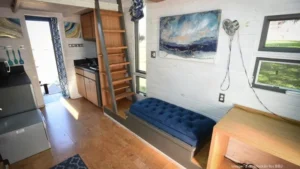Surrounded by vacant buildings, sidewalks with two-foot-tall weeds and assorted debris, the grassy lots in the 1300 block of Holbrook Street in East Baltimore don’t inspire much hope at first glance.
But Christian and Pamela Wilson see more than meets the naked eye. Their vision for years has been to fill this collection of 27 barren properties with homes built for and owned by chronically homeless families. Their nonprofit, Heart’s Place Services, is working with waterfront developer Mark Sapperstein to develop the land, acquired this summer from the city, into Hope Village, which will hold 13 insulated, furnished and utility-equipped houses fashioned out of shipping containers. Each will have its own full kitchen, bathroom, bedroom and adaptable living and dining spaces (plus porches for some).
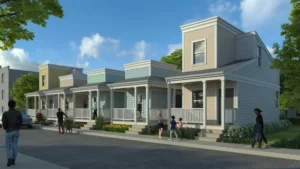
Sapperstein said he’s “going to fund whatever’s necessary” for building costs, and their plan is to sell each 320-square-foot abode for $25,000 — financed by mortgages from Neighborhood Assistance Corp. and underwritten by Bank of America — to buyers with at least one household leader making minimum wage. After completing required coursework on budgeting and financing, families would be able to own a newly furnished home with a monthly payment of around $200, Wilson said.
This project to convert shipping containers into dwellings owned by low- income families is one example of creative collaboration by nonprofits, developers, housing officials and planners to use tiny houses as a viable, yet untapped affordable housing tool. These homes are by no means built for large families or people seeking space. Compared to traditional residences, they depreciate more quickly and, location and design-wise, have fewer options than other housing forms under local zoning and building codes.
But for a city like Baltimore — with more than 3,000 people experiencing homelessness annually and one-in-five households spending over half their income on shelter — supporters say these privately built dwellings can be a new instrument to add affordable housing to vacant space and even help bridge the wealth gap.
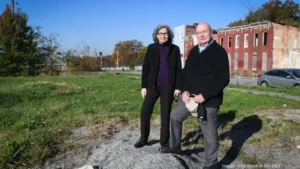
Christian Wilson said he wants this to be part of “a revolution of various cities that have the same problems that we’re facing here” with housing the chronically homeless: “It’s not going to resolve all of the problems, but for those people who are really interested in taking care of their families and doing the best they can, we can really help to begin to stop some of the loss that we’re seeing in our cities.”
The advocacy push for tiny houses — generally considered to be 400 square feet or less — is nothing new. In Maryland, proponents have touted their upside for years, pushing for changes to local policies limiting their placement on existing residential land (such tiny homes are known as auxiliary dwelling units, or ADUs) and, in the case of Baltimore nonprofit Civic Works, laying out a plan for how they can be used to train people in construction skills while offering them a home to call their own.
Now, in 2020, some local developers and public officials are willing to test out their viability at scale, and there’s a small, if growing coalition pushing for it to happen as a movement.
On an October Saturday, about a half-dozen tiny home enthusiasts met over Zoom to discuss policy planning and history, as well as their own projects. LaQuida Chancey invited her peers to join her at a church in Hunt Valley, where she is leading construction of a tiny home community for people experiencing homelessness through her nonprofit, Smalltimore Homes. Some, like Anne Arundel County resident (and hopeful downsizer) Liza Roe and Greg Cantori, a veteran tiny house dweller known as a go-to policy resource for officials and builders, spoke of working with lawmakers to relax restrictions on ADUs.
Justin Fair is the organizer of this group, known as the Maryland Tiny House Coalition, which began meeting this July. Fair wrote his master’s thesis for Morgan State University’s City and Regional Planning program last year on “tiny homes and the Black experience in Baltimore,” and even assembled a guide for how tiny house communities could be built in certain areas around the region, assessing community needs and what local building codes and zoning polices allow for.
He said tiny homes aren’t generally viewed as an affordable, community-
based housing option because of how they’ve been framed as a fad conducive to a quirky, minimalist lifestyle, popularized through TV shows and other media about the tiny-living lifestyle.
But it’s about the “terms and the framing,” he said. Entire villages have already sprung up in Detroit, South Carolina and North Texas, with the developers and organizers saying they can offer a more environmentally sustainable way of living that also provides lower-cost housing and can revitalize economically downtrodden areas. And Maryland has builders ready for the task, Fair said, rattling off a list of names that includes Hobbitat in Oakland, Humble Houses in Germantown and Hagerstown-based I Can Build It.
In particular, advocates preach the benefits of their affordability on a per-unit basis compared to multi-unit apartment buildings, whose development costs include commercial construction crews and adding infrastructure to serve multiple households. Case studies on tiny house villages in Eugene, Oregon, and Olympia, Washington, have noted the cost per unit was substantially lower than that of a new studio apartment. (Crucially, those projects had low acquisition costs for land, received major donations or were built with sweat equity, rather than by hired builders.)
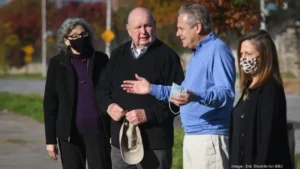
In Baltimore, developer Sam Polakoff is testing this logic for a market-rate development. Polakoff, whose firm Property Consulting Inc. has developed multi-unit buildings like SoHa Union in Lauraville, said “if you start to really do the math… if you look at what their average cost per unit is, even for a one-bedroom, the costs are outrageous.”
Last month, Polakoff shared plans from his firm, Property Consulting Inc., to build 22 tiny homes on foundations on two vacant properties in Northeast Baltimore’s Hamilton neighborhood.
To be clear, his focus for this project is not affordable housing; the envisioned village in Hamilton would remain owned by Polakoff’s company, with homes renting at an estimated $1,000 per month. Still, Polakoff said tiny houses present an opportunity to break the mold in that arena, noting that affordable apartment developments often rely heavily upon tax credits and other government funds to offset building costs, and in balance-sheet terms, are difficult to build without those subsidies.
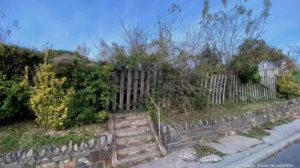
Tiny house development could cost “significantly less and therefore need much less subsidy, which would appear to be a more efficient way to do it,” he said. “It is and should be a very real tool in the affordable housing tool belt.”
Christopher Ptomey, executive director of the Urban Land Institute’s Terwilliger Center for Housing, said the relatively low dependence of tiny house development on government funds compared to, say, low-income apartments reliant on tax credits, is a key benefit.
“The more the models like tiny houses that don’t require government funding can be tested and executed, the more people you’re gonna be able to serve,” he said. “At the end of the day that’s the goal, if you can figure out ways to produce housing you don’t need subsidies for… that’s how you solve the crisis. You’re never gonna have enough government money to solve the crisis.”
The four walls and roof of Civic Works’ mobile tiny house adjacent to the hulking, ornate Clifton Mansion are deceptively spacious. Just shy of 200 square feet, this abode on wheels sports a kitchen with a gas stove, dishwasher, a fridge — all tiny, naturally — plus cabinets and shelving. A toilet and full-sized standing shower sit right inside the doorway. A ladder from the living room leads to the bedroom, a lofted space large enough for a full-size mattress.
Civic Works collaborated with architecture firm Living Design Lab to produce this prototype. The organization has developed a model that trains local residents — particularly youth — to build such a unit for roughly $65,000 in total material costs. Dwellings like this are a better alternative to renovating a townhouse or rowhouse, said the nonprofit’s executive director, Dana Stein, estimating that work costs about three times as much, or $225,000 on average.

But that very format — often seen on shows like “Tiny House Nation” or “Tiny House Hunters” — is challenged from the get-go in Baltimore. City zoning rules don’t allow for a moveable residence — ones built on foundation are permitted — and building code bars adding a lofted sleeping area with little overhead clearance.
Alice Kennedy, the city’s housing commissioner, is among the local officials who have worked to amend rules to make way for this kind of unique development over the years.
“I think having as many tools in the toolbox when it comes to affordable options… is extremely important just because of the vast need that we have across the city with families needing to have shelter and a place to call home,” she said in an interview.
Since 2013, when Kennedy was serving as the city’s sustainability coordinator, she has helped identify sections of Baltimore’s zoning and building codes that did not permit tiny homes, and worked with city agencies, housing advocates, industry professionals and project leaders like the Wilsons to bring their plans to fruition. Among the changes she helped with was the city’s move to adopt new rules this year for design and construction of foundation-based tiny homes — known as Appendix Q in the International Residential Code — to provide clearer standards for builders.
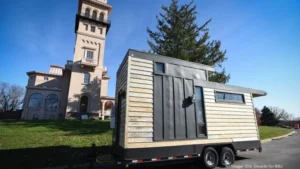
Kennedy points to Detroit as an example of a city that has been able to make tiny homes work for economic development. She saw this firsthand when she accompanied Stein, advocates and interested developers for a 2017 visit there. The group toured a tiny house village, a project for which private and nonprofit partners obtained funding and materials and found would-be homeowners willing to put in the sweat equity to build the homes. Each had a different layout and architectural design, and all were “quality-constructed homes,” she recalled.
“I think it’s a great model and it’s something that we can do here in Baltimore. We have a lot of fantastic organizations — everything from workforce development to nonprofit and for-profit development teams that could come together with a model that’s extremely similar,” she said.
Limiting factors remain for where and how these homes can be built, and the residents have to be few enough in number — not to mention able to downsize — to fit into a micro-living situation. But they’re a worthwhile option at a time of great need, Kennedy said.
Cantori, who was part of the Maryland delegation on the Detroit trip, argues it’s in government’s best interest to find a way to house people and let them build financial independence in the process. He believes Maryland is at the “spark phase” of a movement where tiny house communities will take shape here.
“I see it as not only possible, it’s just a matter of time,” he said. “We will eventually get this to happen because it’s what people want, and it’s what people need.”
